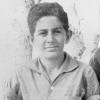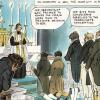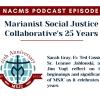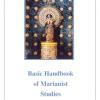NACMS has classified our publications by level to aid you in finding material most helpful to you:
- Basic for those new to the Marianist world and having little or no prior knowledge of Marianist history or the Marianist charism
- Intermediate for those who have some knowledge and understanding of things Marianist
- Advanced for those who have significant knowledge and understanding of things Marianist and want to go deeper
- Resource materials, including prayers, activities, and reflections for individuals and groups
- Reference materials, including source documents and compendia
The resources listed below are found within our e-publications and bookstore. Items available in our library are not listed, but can be found by searching in our library catalog.
Venerable Faustino Pérez-Manglano: A Youth Who Prayed the RosaryAs we mark the anniversary of the initiation of Faustino Pérez-Manglano’s cause for canonization (October 17, 1986), Bro. David Betz, SM, offers his reflection on Faustino’s devotion to the Rosary and his invitation to deepen our spiritual lives through prayer to Mary. |
||
The Witness of the First Lay Marianist ConsecrationBro. Tim Phillips, SM offers this reflection on the first Lay Marianist consecration on February 2, 1801, which marked the beginning of the Marianist Family. |
||
Podcast: An Irish Perspective (Susan Buckley)Susan Buckley is a Lay Marianist living in Dublin, Ireland where the Marianist Family has had a presence since 1967. In this episode of Sharing Our Marianist Stories, Susan shares about her engagement in a virtual Lay Marianist Community with others in the United States and her experience at the 2023 International Lay Marianist Assembly in Madrid. She also sheds light on what it is like to be a Lay Marianist in Ireland amid the current context of the Catholic Church there. |
||
Podcast: The Responsibility of Stewardship (Jon Watase and Laura Koonce)Jon Watase and Laura Koonce are two staff members at Saint Louis School in Hawaii, a Marianist school serving boys in kindergarten through twelfth grade. In this episode of Sharing Our Marianist Stories they share about the impact of the agricultural program that Jon helped establish, how their lives have been impacted by the Marianist Family, and their experience of the 2023 Lay Marianist Assembly in St. Louis. |
||
Podcast: Sharing from the Heart (Jeri Albright and Marceta Reilly)In our latest episode of Sharing Our Marianist Stories, Lay Marianists Jeri Albright and Marceta Reilly share their experience living near Topeka, Kansas, where there aren’t many Marianists. Marceta and Jeri share the origin story of the Harvest Prayer Marianist Lay Community, the impact the community has had on their lives, and the community’s impact on their Catholic Parish. |
||
Podcast: Marianist Social Justice Collaborative's 25 YearsThis special episode is a joint production between NACMS and the Marianist Social Justice Collaborative (MSJC) who is celebrating their 25th anniversary this year. This podcast is a recording of a Zoom conversation that took place between MSJC Director Sarah Gray and three people who were present at MSJC's foundation: Sr. Leanne Jablonski, FMI; Jim Vogt; and Fr. Ted Cassidy, SM. These three Marianists reflect on the origins of MSJC, its accomplishments over the years, and how it has been a model of collaboration in the Marianist Family. |
||
Marianist Heritage Virtual Tour VideosIn January of 2023, to honor Marianist Heritage Month, NACMS created eight virtual tours of significant locations in Marianist History. |
||
Podcast: Commitment to Community (Ann Hirt and Carol Ramey)Lay Marianists Carol Ramey and Ann Hirt originally met as undergraduate students at the University of Dayton in the 1960s, where they both became involved in the UD Sodality. After graduating, both of them joined the Marianist Visitation State Community, where they have been members for over 50 years. In this podcast, they reflect on how their friendship, their Marianist commitment, and relationship with Mary has sustained them for the past 50 years. Carol Ramey was also the previous director of NACMS, where she served the Marianist Family for many years before her retirement in 2016. |
||
Basic Handbook of Marianist StudiesThe Basic Handbook of Marianist Studies is a key resource exploring the historical trends related to the origins of Marianist life and its development. Compiled and created by Bro. Lawrence J. Cada, SM, and Carol Ramey, it is a one-stop shop for historically-rich content on the origins and historical markers along the Marianist journey. |
||
Marianist Vow of Stability and the Marianist StateJust what is the "State of Religious Living in the World"? And, how does one make a permanent commitment to live a vocation as a lay Marianist? Albert E. Prendergast, a member of the Visitation State Community, examines these questions as he traces the roots of commitment to lay Marianist life and its implications for today. |









